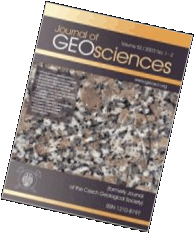 Export to Mendeley
Export to MendeleyBohemian Massif
transpression
U-Pb zircon dating
emplacement
European Variscides
Miřetín Pluton
Original Paper
Emplacement, structural and P-T evolution of the ˜346 Ma Miřetín Pluton (eastern Teplá-Barrandian Zone, Bohemian Massif): implications for regional transpressional tectonics
Journal of Geosciences, volume 56 (2011), issue 4, 343 - 357
DOI: http://doi.org/10.3190/jgeosci.109
The calc-alkaline Miřetín Pluton (newly dated at 346 Ma ± 5 Ma; an U-Pb age obtained by laser-ablation ICP MS method on zircons) is a NNE-SSW elongated intrusive body emplaced into the upper- to mid- crustal rocks of the Polička Unit (eastern Teplá-Barrandian Zone; Bohemian Massif). Its composition reveals similarities to other calc-alkaline granitoids, which are mostly interpreted as products of magma mixing between the basic magmas derived from mantle wedge above a subduction zone with crustally-derived acid melts. The conditions of magma crystallization estimated at 653-681 °C and 0.29-0.43 GPa roughly correspond to peak metamorphic evolution of the host volcano-sedimentary rocks of the northwestern part of the Polička and Hlinsko units. The Miřetín Pluton was emplaced into a NNE-SSW oriented transpressional domain, well recognized on a regional scale along the eastern margin of the Teplá-Barrandian Zone. During, or shortly after, the magma emplacement, the Miřetín Pluton was affected by pervasive submagmatic to high-T solid-state deformation, reflecting an additional strain increment of regional transpression in a narrow zone of thermal softening. Sharply superimposed low-T solid-state fabric preserved along the western part of the Pluton was connected with normal shearing between the Polička Unit at the bottom and the overlying Hlinsko Unit after 335 Ma.
Webdesign inspired by aTeo. Hosted at the server of the Institute of Petrology and Structural Geology, Charles University, Prague.
ISSN: 1803-1943 (online), 1802-6222 (print)
email: jgeosci(at)jgeosci.org


IF (WoS, 2023): 1.1
5 YEAR IF (WoS, 2023): 1.5
Policy: Open Access
ISSN: 1802-6222
E-ISSN: 1803-1943